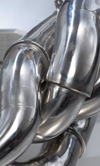Formula One exhausts
 At present, exhausts occupy a strange position in Formula One engine development and are treated very differently in the regulations from most components that make up these highly specialised engines.
At present, exhausts occupy a strange position in Formula One engine development and are treated very differently in the regulations from most components that make up these highly specialised engines.
Along with the snorkel (air horn), they are the only components able to influence engine performance that are not deemed to fall within the 'sealed engine', inside which no development or design changes are allowed, except for clearly defined reasons such as cost-cutting or reliability. Since engine homologation has been imposed in Formula One there have been a couple of opportunities to re-optimise engine performance, owing to the reduced maximum engine speed limits, first bringing the maximum rpm down to 19,000 and then reining the engine manufacturers in further with an 18,000 rpm limit.
Given the restriction on other areas of engine development and the freedom to do as the development engineers wish with regards to exhaust system design, we might therefore expect exhaust development to have been an area of frantic activity. This isn't true though in many cases, and most major changes are due to chassis influences rather than for engine performance reasons.
In more normal circumstances, as in with free development, as the engine manufacturers look to improve some aspect of engine performance - besides peak power or torque, this may equally well be fuel economy or 'driveability', even in Formula One - they would alter several aspects of the engine design. Changes in port design and cam timing might well be accompanied by changes to inlet length or exhaust geometry as we seek to influence the gas exchange processes.
With the current Formula One rules, there is no scope to use the broad range of options outlined above that are normally available to the development engineers working in other race series. Changes to exhaust systems in isolation are likely to have limited effect in terms of influencing engine output (unless large changes are made) as the other parameters we might choose to alter are fixed due to homologation.
The exemption of the exhaust system from the homologated engine regulations is designed to allow freedom for the chassis manufacturers and race teams to do as they wish with the design of the car packaging and aerodynamics. There is a considerable mass flow through a Formula One engine, and the careful direction of the exhaust gas can affect car performance and durability. In the past couple of years we have seen how influential aerodynamic advantages have been for the teams; the 'F-duct' in particular was an important development, making a real performance difference and being visible to the average punter watching the TV.
Unfortunately for the race engine business, this freedom is deemed more important than allowing similar technical latitude to the engine manufacturers. As the manufacturers are notably coy about releasing any technical information, and take special care to keep engines covered at all times, the FIA has clearly noted that there is more technical interest for the average Formula One fan in the developments they can see on the chassis - and which are detailed in the general motorsports press - than those they never see or hear about concerning engines.
There may be a lesson in there somewhere.
Fig. 1 - Formula One exhaust systems, despite being free of development restrictions, are often changed for chassis performance reasons. The large exhaust mass flows can have an important effect on car performance (Courtesy of Good Fabrications)
Written by Wayne Ward